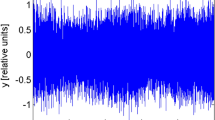Abstract
The products of Wuhan University with 5-min sampling are used to analyze the characteristics of BeiDou satellite clocks. Two nanoseconds root-mean-square (RMS) variations are obtained for 1-day quadratic fits in the sub-daily region. The relativistic effects of BDS clocks are also studied. General relativity predicts that linear variation of the semimajor axes of geostationary and inclined geosynchronous satellites causes a quadratic clock drift with a magnitude at the 10−16/day level. The observed drift is higher than what general relativity theory would produce. Several periodic terms are found in the satellite clock variations through spectrum analysis. In order to identify the origin of the BDS clock harmonics, a correlation analysis between the period or amplitude of the harmonics and properties of the satellite orbits is performed. It is found that the period of the harmonics is not exactly equal to the orbit period, but rather the ratio of the orbit period to clock period is almost the same as that of a sidereal day to solar day. The BDS clocks obey white frequency noise statistics for intervals from 300 s to several thousands seconds. For intervals greater than 10,000 s, all the BDS satellites display more complex, non-power-law behavior due to the effects of periodic clock variations.











Similar content being viewed by others
References
CSNO (2013) BeiDou navigation satellite system signal in space interface control document open service signal (version 2.0). China satellite navigation office Dec 2013
Epstein M, Stoll E, Fine J (2001) Observable relativistic frequency steps induced by GPS orbit changes. In: Proceedings of the 33rd annual precise time and time interval (PTTI) systems and applications meeting, Long Beach, California, USA, 27–29 Nov 2001, pp 493–507
Gong H, Ni S, Mou W, Zhu X, Wang F (2012) Estimation of COMPASS on-board clock short-term stability. European frequency and time forum (EFTF), 2012, 23–27 April 2012, pp 383–386. doi:10.1109/EFTF.2012.6502407
Gong H, Yang W, Sha H, Zhu X, Wang F (2013) Frequency stability estimation of compass on-board clock based on smoothed broadcast ephemeris. European frequency and time forum & international frequency control symposium (EFTF/IFC), 2013 Joint, 21-25 July 2013, pp 289–294. doi:10.1109/EFTF-IFC.2013.6702233
Gonzalez Martinez FJ (2013) Performance of new GNSS satellite clocks. KIT Scientific Publishing, Karlsruhe. doi:10.5445/KSP/1000036610
Greengard L, Lee J (2004) Accelerating the Nonuniform Fast Fourier Transform. SIAM Rev 46(3):443–454. doi:10.1137/S003614450343200X
Han C, Yang Y, Cai Z (2011) BeiDou navigation satellite system and its time scales. Metrologia 48:213–218
Hauschild A, Montenbruck O, Sleewaegen J-M, Huisman L, Teunissen PG (2012a) Characterization of compass M-1 signals. GPS Solut 16(1):117–126. doi:10.1007/s10291-011-0210-3
Hauschild A, Montenbruck O, Steigenberger P (2012b) Short-term analysis of GNSS clocks. GPS Solut 17(3):295–307. doi:10.1007/s10291-012-0278-4
IS-GPS-200G (2013) Global positioning systems directorate system engineering & integration interface specification IS-GPS-200G. Washington, DC, USA
Kouba J (2004) Improved relativistic transformations in GPS. GPS Solut 8(3):170–180
Lee J-Y, Greengard L (2005) The type 3 nonuniform FFT and its applications. J Comput Phys 206(1):1–5. doi:10.1016/j.jcp.2004.12.004
Lou Y, Liu Y, Shi C, Yao X, Zheng F (2014) Precise orbit determination of BeiDou constellation based on BETS and MGEX network. Sci Rep 4. doi:10.1038/srep04692
Montenbruck O, Steigenberger P, Schönemann E, Hauschild A, Hugentobler U, Dach R, Becker M (2011) Flight characterization of new generation GNSS satellite clocks. The 24th international technical meeting of the satellite division of The Institute of Navigation (ION GNSS 2011), Portland OR, USA, 21–23 Sep 2011, pp 2959–2969
Montenbruck O, Hugentobler U, Dach R, Steigenberger P, Hauschild A (2012) Apparent clock variations of the Block IIF-1 (SVN62) GPS satellite. GPS Solut 16(3):303–313
Montenbruck O, Hauschild A, Steigenberger P, Hugentobler U, Teunissen P, Nakamura S (2013) Initial assessment of the COMPASS/BeiDou-2 regional navigation satellite system. GPS Solut 17(2):211–222. doi:10.1007/s10291-012-0272-x
Pearlman MR, Degnan JJ, Bosworth JM (2002) The international laser ranging service. Adv Space Res 30(2):135–143. doi:10.1016/S0273-1177(02)00277-6
Rochat P (2010) Onboard atomic clocks in global navigation satellite system. SATW congress 2010, Zurich, Switzerland, November 11
Senior KL, Ray JR, Beard RL (2008) Characterization of periodic variations in the GPS satellite clocks. GPS Solut 12(3):211–225
Sesia I (2008) Estimating the Allan variance in the presence of long periods of missing data and outliers. Metrologia 45(6). doi:10.1088/0026-1394/45/6/S19
Shi C et al (2012) Precise orbit determination of Beidou Satellites with precise positioning. Sci China Earth Sci 55(7):1079–1086. doi:10.1007/s11430-012-4446-8
Springer TA, Beutler G, Rothacher M (1999) A new solar radiation pressure model for GPS satellites. GPS Solut 2(3):50–62. doi:10.1007/PL00012757
Steigenberger P, Hugentobler U, Hauschild A, Montenbruck O (2013) Orbit and clock analysis of Compass GEO and IGSO satellites. J Geodesy 87(6):515–525. doi:10.1007/s00190-013-0625-4
Swift ER, Hermann BR (1988) Orbit period frequency variations in the GPS satellite clocks. In: Proceedings of the 20th annual precise time and time interval (PTTI) applications and planning meeting, Vienna, VA (USA), Nov 29–Dec 1, pp 87–100
Urschl C, Beutler G, Gurtner W, Hugentobler U, Schaer S (2007) Contribution of SLR tracking data to GNSS orbit determination. Adv Space Res 39(10):1515–1523. doi:10.1016/j.asr.2007.01.038
Zhao QL, Guo J, Li M, Qu LZ, Hu ZG, Shi C, Liu JN (2013) Initial results of precise orbit and clock determination for COMPASS navigation satellite system. J Geodesy 87(5):475–486. doi:10.1007/s00190-013-0622-7
Acknowledgments
The authors are grateful to Jim Ray for valuable discussions concerning research methods and also revisions of this paper. We would like to thank Mr. Jing Guo and Mr. Maorong Ge for the discussions, the IGS MGEX campaign for providing multi-GNSS data and products, and also the ILRS for providing the satellite laser ranging observations of BDS satellites. Finally, the authors are also grateful for the comments and remarks of the reviewers, which helped to improve the manuscript. This work is supported by the National Nature Science Foundation of China (Nos. 41231174; 41374034).
Author information
Authors and Affiliations
Corresponding author
Rights and permissions
About this article
Cite this article
Wang, B., Lou, Y., Liu, J. et al. Analysis of BDS satellite clocks in orbit. GPS Solut 20, 783–794 (2016). https://doi.org/10.1007/s10291-015-0488-7
Received:
Accepted:
Published:
Issue Date:
DOI: https://doi.org/10.1007/s10291-015-0488-7




